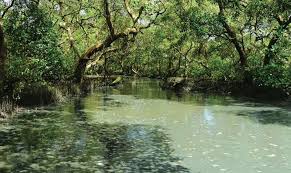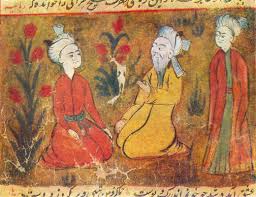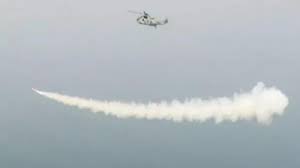MISHTI Scheme

- 03 Mar 2025
In News:
Gujarat has emerged as the national leader in mangrove afforestation, covering 19,020 hectares in just two years under the Centre’s ‘MISHTI’ scheme.
Key Highlights:
- The Mangrove Initiative for Shoreline Habitats and Tangible Incomes (MISHTI) scheme was launched in 2023 under the Union Budget for 2023-24.
- The scheme aims to restore degraded mangrove ecosystems and increase India’s mangrove cover, enhancing coastal resilience while fostering sustainable livelihoods for coastal communities.
- Implemented from 2023 to 2028, the scheme is funded through various channels, including the CAMPA Fund (Compensatory Afforestation Fund Management and Planning Authority), MGNREGS (Mahatma Gandhi National Rural Employment Guarantee Scheme), and other governmental and private funding sources.
- The initiative also supports India’s participation in the global Mangrove Alliance for Climate (MAC) launched at COP27.
Key Objectives of MISHTI
- Ecological Restoration: To restore degraded mangrove ecosystems and expand mangrove cover across coastal areas.
- Coastal Resilience: To strengthen coastal resilience against climate change, such as coastal erosion and rising sea levels.
- Livelihood Generation: To promote ecotourism, sustainable livelihoods, and fishing opportunities for coastal communities.
- Climate Change Mitigation: The scheme plays a crucial role in protecting shorelines from storms, supporting India's commitments under the Paris Agreement and the UN Sustainable Development Goals (SDGs).
Gujarat’s Role in MISHTI Scheme
- Gujarat has emerged as the national leader in mangrove afforestation under the MISHTI scheme, planting over 19,000 hectares of mangroves in just two years.
- The state is spearheading the mangrove expansion efforts, with its coastline covering diverse ecosystems such as mangroves, coral reefs, and seagrasses.
- Gujarat has surpassed the Central Government’s target of planting 540 sq. km of mangroves in five years, completing plantation across 190 sq. km in the initial two years of the scheme.
Mangrove Distribution in Gujarat
- Gujarat's mangrove cover is distributed strategically across different coastal regions:
- Kutch: 799 sq. km, including the Gulf of Kutch, home to the Marine National Park and Wildlife Sanctuary.
- Other Coastal Districts: Jamnagar, Rajkot (Morbi), Porbandar, DevbhoomiDwarka (236 sq. km).
- Central and Southern Belt: Includes Bhavnagar, Ahmedabad, Anand, Bharuch, Surat, Navsari, and Valsad, covering 134 sq. km, with important areas like the Gulf of Khambhat and Dumas-Ubhrat.
- Saurashtra Region: Amreli, Junagadh, and Gir-Somnath maintain 6 sq. km of mangrove cover.
Significance of Mangroves
- Erosion Prevention: Mangroves act as a natural barrier, protecting coastal regions from erosion caused by waves and storms.
- Biodiversity Support: They provide vital breeding grounds for fish and other marine species, supporting coastal livelihoods.
- Climate Resilience: Mangroves help mitigate the effects of climate change by shielding vulnerable coastal communities from cyclones, reducing salinity, and preserving agricultural lands.
Global and National Mangrove Status
- Global Mangrove Distribution: Mangroves are found in tropical and subtropical regions worldwide, providing critical ecosystem services.
- India’s Mangrove Cover: According to the India State of Forest Report 2023, India has a total mangrove cover of 4,991.68 km², which accounts for 15% of the country’s total geographical area. The MISHTI scheme plays a pivotal role in further expanding this cover.
Amir Khusrau

- 03 Mar 2025
In News:
In his address to the 25th edition of Jahan-e-Khusrau at New Delhi’s Sunder Nursery, Prime Minister Narendra Modi described the annual music festival that commemorates the Sufi poet-musician Amir Khusrau as imbued with the “fragrance of the soil of Hindustan”.
Introduction
- Amir Khusrau, a 13th-century poet, musician, and scholar, is a prominent figure in India’s cultural history.
- Known as Tuti-yi-Hind (the Parrot of India), Khusrau’s contributions spanned literature, music, and the Sufi spiritual tradition.
- Revered for his role in shaping India’s syncretic culture, blending Persian, Turkic, and Indian elements.
Early Life and Background
- Born in 1253 in Patiyali, Uttar Pradesh, to a Turkic father and Indian Muslim mother.
- His family migrated to India due to Mongol invasions of Transoxiana.
- Grew up under the patronage of the Delhi Sultanate, serving five rulers: MuizuddinQaiqabad, JalaluddinKhalji, AlauddinKhalji, Qutbuddin Mubarak Shah, and GhiyasuddinTughlaq.
Literary Contributions
- Wrote in Persian and Hindavi, blending Turkic, Persian, and Indian traditions.
- Contributed significantly to the development of Hindavi, the precursor to modern Hindi and Urdu.
- Works include Divans (poetry collections), Mathnawis (narrative poems), and treatises.
- Advocated for Hindu-Muslim unity, promoting syncretic culture (Ganga-JamuniTehzeeb).
- Known for writing riddles, proverbs, and playful verses, which made literature accessible to the common people.
- Praised Hindu philosophical thought in his works, such as MasnaviNuhSiphir.
Musical Contributions
- Credited with creating several ragas, developing khayal (a classical Hindustani music form), and tarana (rhythmic vocal composition).
- Played a significant role in popularizing qawwali, a devotional Sufi music genre, by blending Persian, Arabic, and Indian musical traditions.
- Believed to have invented the sitar and tabla, though evidence is debated.
- Famous qawwalis include ChhaapTilak, Zehal-e-Maskeen, and Sakal Ban PhoolRahiSarson.
Role in the Delhi Sultanate
- Served as a court poet for at least five Delhi Sultans over five decades, a testament to his literary excellence.
- His compositions were vital in enhancing the Sultan’s political and cultural legitimacy.
- Sultan JalaluddinKhalji bestowed upon him the title Amir in recognition of his contributions to poetry.
Spiritual and Sufi Influence
- A devoted disciple of the Chishti Sufi saint NizamuddinAuliya, whose teachings on love and devotion to God deeply influenced Khusrau’s poetry and music.
- Balanced his role as a court poet with devotion to the Sufi order, bridging the worlds of royal courts and spiritual practices.
- His deep spiritual connection to NizamuddinAuliya is immortalized by their shared burial site in Delhi.
Sufism in India
- Sufism is the mystical and spiritual dimension of Islam, emphasizing love, devotion, and inner purification.
- Sufism emerged as a reaction to the rigidity of institutionalized religion and developed alongside India’s Bhakti movement.
- Key Sufi Orders in India:
- Chishti Order: The most influential in India, founded by KhwajaMoinuddin Chishti, focusing on love, devotion, and harmony.
- Suhrawardi Order: Focused on combining religious knowledge with mysticism.
- Naqshbandi Order: Opposed innovations like musical recitals and pilgrimages.
- Rishi Order: Based in Kashmir, drawing from the Shaivite bhakti tradition.
Impact of Sufism in India
- Sufism promoted religious tolerance, social reform, and a deep connection to spirituality.
- It attracted marginalized communities and weakened caste hierarchies.
- Sufi shrines and dargahs became pilgrimage sites for spiritual blessings.
- Influenced Indian music (especially qawwali) and literature, with poets like Bulleh Shah and Sultan Bahu.
- Promoted Sulh-e-Kul (peace with all), a concept that influenced Akbar’s religious tolerance policies.
Khusrau’s Lasting Legacy
- Amir Khusrau’s influence extends across literature, music, and spirituality in India.
- His poetry and music are celebrated today in both sacred and secular contexts.
- His works laid the foundation for the development of Urdu and Hindi literature.
- Khusrau’s teachings on Hindu-Muslim unity and cultural synthesis remain relevant in contemporary India.
Agritourism in Himachal Pradesh

- 03 Mar 2025
In News:
With a public debt exceeding ?1 lakh crore, Himachal Pradesh (HP) is actively exploring sustainable and innovative ways to boost its economy. Tourism contributes around 7% to the state's GDP, and the state is now integrating agriculture with tourism through agritourism to enhance rural livelihoods and extend tourist engagement.
What is Agritourism?
Agritourism is a form of tourism where visitors are engaged in agricultural activities such as farm stays, crop tours, and interactive farming experiences. It provides farmers with additional income, promotes sustainable tourism, and preserves agricultural and cultural heritage.
Opportunities and Features in Himachal Pradesh
Crop and Farm-Based Tourism
- Tulip farming in Kangra has already attracted tourist interest.
- Scope for cultivation of high-value crops like saffron and Himalayan medicinal herbs.
- Promotion of nutraceutical farming to tap into the growing demand for preventive health-based tourism.
Educational Tourism
- Farm visits can be organized for school and college students to raise awareness about food systems and sustainability.
- Farmers can charge nominal fees, benefiting financially while educating the younger generation.
Cultural and Experiential Engagement
- Local youth can be involved in storytelling, showcasing unique farming practices and regional traditions.
- Farm stays, panchayat-level fairs, and cultural activities (folk music, traditional cuisine) can enrich tourist experiences.
Economic and Employment Benefits
- Diversifies farmer income beyond conventional crops like apples.
- Creates jobs for local guides, cooks, transport providers, and artisans, particularly empowering rural women and youth.
Market Integration
- Organizing crop fairs and displaying agricultural products in urban spaces (e.g., malls) can help secure pre-orders and boost local brands.
- Encourages direct farmer-consumer connections.
Environmental and Social Impact
- Promotes organic farming, eco-friendly practices, and water conservation.
- Builds social capital by fostering urban-rural understanding and collaboration.
- Requires visitor sensitization and capacity building among locals to ensure respectful, responsible tourism.
Learning from Other States
- Maharashtra: First state to promote agritourism (Agro-Tourism Development Corporation, 2005); successful models include Baramati's pilot farm and Nashik’s vineyards.
- Kerala: Agro-Tourism Network for spice cultivation experiences.
- Sikkim: Organic farming tourism in the first organic state of India.
- Punjab, Rajasthan, Gujarat, Bihar, NE States: Promote local heritage, farming traditions, and eco-tourism (e.g., Ziro Valley’s wet rice farming, Amul’s dairy tourism).
Policy and Government Support
- Swadesh Darshan Scheme: Develops thematic rural and tribal tourism circuits.
- DekhoApnaDesh: Encourages domestic tourism in lesser-known destinations.
- PMJUGA: Focus on tribal homestays and livelihood promotion.
- National Strategy for Promotion of Rural Homestays (2022): Supports agritourism under Atmanirbhar Bharat.
- Agriculture Infrastructure Fund: Helps build infrastructure and marketing support for farm-based tourism.
Way Forward for Himachal Pradesh
- Develop a dedicated agritourism policy, like Goa’s, focusing on farm diversification and long-term returns.
- Promote public-private partnerships (PPP) for integrated agritourism models in each district.
- Leverage the nutraceutical potential of Himalayan herbs to attract health-conscious visitors.
- Institutionalize farm festivals, crop exhibitions, and story-driven agritourism to diversify Himachal’s tourism landscape.
Naval Anti-Ship Missile – Short Range (NASM-SR)

- 03 Mar 2025
In News:
The Defence Research and Development Organisation (DRDO) and the Indian Navy successfully conducted flight trials of the indigenous Naval Anti-Ship Missile – Short Range (NASM-SR) with a ‘Man-in-Loop’ capability from a Seaking 42B naval helicopter at the Integrated Test Range (ITR), Chandipur.
Key Features and Capabilities:
- Man-in-Loop Functionality:
- Provides real-time human intervention during flight.
- Enables in-flight retargeting by transmitting live seeker images to the pilot through a high-bandwidth two-way data link.
- Offers tactical flexibility in selecting and engaging specific targets among multiple options.
- Guidance and Navigation:
- Launched in Bearing-Only Lock-On After Launch (BOLOAL) mode.
- Equipped with an Indigenous Imaging Infra-Red (IIR) Seeker for terminal phase guidance.
- Uses an Indigenous Fiber Optic Gyroscope-based Inertial Navigation System (INS) and a Radio Altimeter for accurate mid-course and low-altitude navigation.
- Design and Control:
- Features Electro-Mechanical Actuators and Jet Vane Control for enhanced maneuverability.
- Integrated avionics module, thermal batteries, and PCB warhead support precise targeting and mission efficiency.
- Stealth and Strike Capability:
- Operates in Sea-Skimming Mode to evade radar detection.
- Demonstrated a direct hit on a small ship target at its maximum range during trial.
- Propulsion:Powered by solid propulsion, featuring an in-line ejectable booster and long-burn sustainer.
Development and Significance:
- Jointly developed by DRDO and the Indian Navy.
- Key DRDO labs involved:
- Research Centre Imarat (RCI)
- Defence Research and Development Laboratory (DRDL)
- High Energy Materials Research Laboratory (HEMRL)
- Terminal Ballistics Research Laboratory (TBRL)
- Marks India’s capability in indigenous anti-ship missile systems with advanced features like man-in-loop control and high-precision targeting.
- Enhances India’s naval warfare and coastal defense capabilities, aligning with Atmanirbhar Bharat in defense manufacturing.
NASA’s Lunar Trailblazer and IM-2 Mission

- 03 Mar 2025
In News:
NASA launched the Lunar Trailblazer spacecraft aboard a SpaceX Falcon 9 rocket from Kennedy Space Center to enhance understanding of water distribution on the Moon—crucial for long-term human exploration under the Artemis program.
Lunar Trailblazer Mission:
- Type: Small satellite (orbiter); part of NASA’s Small, Innovative Missions for Planetary Exploration (SIMPLEX) program.
- Developed by: NASA in collaboration with Lockheed Martin.
- Objective:
- Map and analyze the presence of water, particularly in permanently shadowed craters near the Moon’s poles.
- Study the lunar water cycle and evaluate water as a potential resource for future missions.
- Instruments:
- Lunar Thermal Mapper (LTM): Measures surface temperature to track water movement.
- High-resolution Volatiles and Minerals Moon Mapper (HVM3): Detects spectral signatures of water molecules.
- Timeline:
- Fuel-efficient trajectory to reach the Moon in 4 months.
- Mission duration: At least 2 years of mapping operations.
- Significance:
- Supports Artemis program objectives—long-term human presence on the Moon.
- Identifies potential water sources for drinking, fuel, and oxygen.
- Enhances understanding of water on airless planetary bodies and may offer clues to Earth’s water origins.
IM-2 Mission and Intuitive Machines’ Lunar Lander:
- Landing Site:Mons Mouton, near the Moon’s south pole (landing scheduled for March 6).
- Under: NASA’s Commercial Lunar Payload Services (CLPS) and Artemis campaign.
Key Scientific Objectives and Instruments:
- Polar Resources Ice Mining Experiment-1 (PRIME-1):
- TRIDENT Drill: Extracts lunar soil samples.
- MSolo Spectrometer: Detects volatile compounds in samples (e.g., water vapor).
- Laser Retroreflector Array (LRA): Provides a precise, passive reference point for future orbiters using laser ranging.
- Micro Nova Hopper (“Grace”):
- Autonomous drone developed under NASA’s Tipping Point initiative.
- Capable of hopping into shadowed craters to collect and transmit data.
- Nokia Lunar Surface Communications System (LSCS):
- 4G/LTE system for high-definition video, telemetry, and command messaging.
- Supports inter-device connectivity between the lander, rover, and hopper.
Strategic Importance:
- Pioneers in-situ resource utilization (ISRU) demonstrations.
- Tests surface communications and autonomous mobility systems.
- Lays groundwork for sustainable human presence and commercial space infrastructure.
